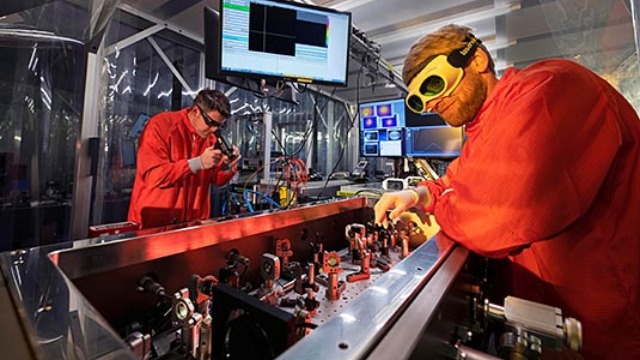Researchers at the Laboratory for Attosecond Physics have developed a completely new type of laser measurement system for analyzing the molecular composition in biological systems. It can detect the smallest changes in the molecular composition of organisms.
Various types of molecules circulate in organisms. The metabolism constantly creates a variety of new molecules in the cells, which are also released into the environment, for example into the blood. One of the major goals of biomedicine is to record this molecular mix in detail and thus obtain information about the state of the organism. Degenerate cells such as cancer cells in the human body also produce very characteristic molecules. They are often the first sign of an illness. The problem with this is that there are very few known indicator molecules of this type, which usually circulate in the blood in extremely low concentrations anyway. It is accordingly difficult to prove them. Biomedical scientists assume, however, that there are many such molecular disease signatures in different molecular classes such as protein, sugar or fat derivatives. The big challenge is to detect them comprehensively and precisely enough with a single method.
To get closer to this goal, an interdisciplinary team of physicists, biologists and data scientists from the Laboratory for Attosecond Physics (LAP) at LMU and the Max Planck Institute for Quantum Optics under the direction of Ferenc Krausz , holder of the Chair for Experimental Physics / Laser Physics, developed a new laser measuring system. With its help, it is possible to obtain fingerprints of the molecular composition of biological samples of any kind in the form of infrared light. The technology works with an unprecedented sensitivity and can be used for any class of biomolecules.
The system is based on technologies developed in the laboratory for attosecond physics for ultra-short-term metrology. The new laser spectrometer, built by the team around the physicist Ioachim Pupeza, is based on the emission of extremely strong infrared laser pulses over a broad spectrum in the infrared wavelength range, which last only femtoseconds. A femtosecond is one millionth of a billionth of a second. The principle behind it: Molecules are excited to vibrate by the ultra-short infrared laser pulses. The light pulses act on the electronically bound particles like a short hammer blow on a tuning fork. The molecules then continue to vibrate independently, thereby emitting coherent light with characteristic wavelengths / frequencies. The new technology detects the entire vibrating light wave. Every molecular connection vibrates at certain natural frequencies and thus contributes a well-defined part to the detected light wave. No molecule can hide here anymore.
“With our laser, we now have a broad wavelength range in the infrared, from six to twelve micrometers, covered for the excitation of molecules,” explains Marinus Huber , co-first author of the study and member of the team of biologist Dr. Mihaela Zigman , who was also involved in the experiments in the laboratory for attosecond physics. “Unlike mass spectroscopy, for example, this method gives us access to all types of molecules that make up biological samples,” explains Zigman.
The short laser pulses for molecular excitation consist of only a few vibrations of light. The system achieves twice the radiation brilliance, i.e. density of photons, than conventional synchrotrons, in which radiation for similar molecular spectroscopy was previously generated. In addition, the infrared radiation is spatially and temporally coherent. All physical parameters together are responsible for the extremely high sensitivity of the new laser system. This means that even very small specific molecular concentrations can be detected and the “molecular fingerprint” can be created very precisely. The new physical parameters now make it possible for the first time to illuminate living water samples that are up to 0.1 mm thick with infrared light and thus to analyze them with unprecedented sensitivity.
“This precise measurement of changes in the molecular composition of body fluids opens up new opportunities for biology and medicine and could be used in particular in the early detection of diseases in the future,” says Zigman. (MPG / LMU) Nature 2020.
Reference
Field-resolved infrared spectroscopy of biological systems. Ioachim Pupeza, Marinus Huber, Michael Trubetskov, Wolfgang Schweinberger, Syed A. Hussain, Christina Hofer, Kilian Fritsch, Markus Poetzlberger, Lenard Vamos, Ernst Fill, Tatiana Amotchkina, Kosmas V. Kepesidis, Alexander Apolonski, Nicholas Karpowicz, Vladimir Pervak, Oleg Pronin, Frank Fleischmann, Abdallah Azzeer, Mihaela Žigman & Ferenc Krausz. Nature volume 577, pages 52–59 (2020), https://doi.org/10.1038/s41586-019-1850-7.
This article has been republished from the following materials. Note: material may have been edited for length and content. For further information, please contact the cited source.


















